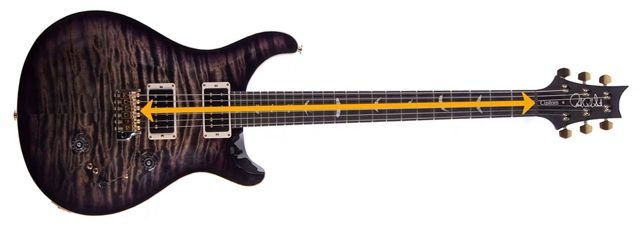The scale length of a guitar is the distance between the nut and the bridge. This distance directly influences the touch, comfort and tone of a guitar.

Based on a standard tuning, and in the same string gauge, a shorter section of string compared to a longer one, will require less tension to reach the corresponding note of a classical tuning.
For example, if we place a capo on the first fret of a guitar with a long 25.5″ scale like a Stratocaster or Telecaster, we will get a 24″ scale like the Fender Jaguar model.
Obviously the notes we obtain after placing the capo on the first fret would be a semitone higher than the standard tuning. Consequently, we would have to loosen all the guitar strings by a semitone to return to standard tuning.
Consequently, the strings are less tense and softer to the touch, thus achieving greater comfort when stretching the strings. In addition, the guitar tone will be less bright, because as the oscillation or wavelength of the strings increases, compared to the tighter strings due to a long scale, the sound will be more bass.
In a shorter scale the tone will also be dirtier, as this wider range of string oscillation causes some occasional buzzing, especially on wound strings.
Although this type of fret buzz is considered a musical part, especially in distorted sounds. Something that is even appreciated and essential to achieve a really optimal crunchy sound. This often happens on the guitar. The imperfect is the really optimal.
Also, the frets are closer together, as the scale of the guitar is shorter, which increases playing comfort for people who do not have very large hands.
Short Scale
One of the guitars with a shorter scale length are the Rickenbacker C Series, such as the 325C64. Very popular for being one of the Rickenbacker models used by John Lennon in the Beatles.
This model has a scale of only 21 Inches. For all the aforementioned, it is deducible that this guitar will need to mount high-gauge strings. Since thin strings on such a short scale would be too loose in standard tuning.
For example, the Rickenbacker 95406 12-54 gauge string model is the one specially designed for this guitar. These strings are not easy to find, but we can always fit a set of strings from another brand with the same gauge.
The Gibson Byrdland semi-acoustic guitar has a 23.5 Inches scale. The Gibson Byrdland is an extraordinary guitar, although it is a true rarity, that a guitar of this style has such a short scale.
Obviously, we should also mount a thick string gauge on this guitar, even more so in the case of a semi-acoustic guitar or Jazz guitar.
We moved on to the 24 Inches scale used on Fender models like the Duo Sonic, Mustang, and Jaguar. Models that were initially aimed at the youngest members of the house, but which have been used by stars like John Frusciante.
If yours is Alternative Rock, it wouldn’t hurt to take a look at one of these models.
PRS Guitars Scale Length
Some single cutaway PRS models use a 24.5 Inches scale, such as the PRS SE 245. Scale below the standard short 24.75″ scale found on Gibson Les Paul models.
A very comfortable guitar to play, as it has less spaced frets, and also makes it easier to stretch the strings, as they are even less tense than in traditional Gibson models.
The measure of 24.5 inches, is also used by the Danelectro brand in models like ’64.
Slightly below the short Gibson scale we have some Gretsch-brand models with a 24.6 Inches scale, such as the Gretsch G5420T Electromatic with a semi-acoustic body, or the Gretsch 6128 Duo Jet with a solid body.
Standard Short Scale
We arrive at a scale length of the guitar cataloged as standard: 24.75 Inches. Generally known simply as short scale. Generally used in the most famous and imitated Gibson models such as the Les Paul, SG or ES-335.
Although this scale is also used as a standard by the Rickenbacker brand, to develop many of its semi-acoustic and solid body models.
We got to the scale of just 25 Inches. Something very characteristic and hallmark of the best-known PRS models, such as the Custom 24. This measure is also used in the development of the legendary Danelectro models such as the 59 series, or in the ’63 and ’67 Dano models.
Long Scale Guitar
We move on to another of the standard measures in terms of guitar scale length. The so-called long scale of 25.5 Inches, used in historical models of the Fender brand such as the Jazzmaster, Telecaster and Stratocaster.
This measure is classified simply as a long scale, given its wide use by countless brands that develop Telecaster or Stratocaster style models. Also used in the development of the famous Superstrat style guitars, such as the models produced by Schecter, Jackson, Charvel or Ibanez.
This measure has the advantage of having more space to place more frets, and a more defined tone is obtained compared to Gibson models. Although the instrument would need thinner strings for standard tuning, as more tension would be felt on the heavy gauge strings.
Scale Length For a 7 String Guitar
We increased the scale of the guitar one more inch, to 26.5 inches. Standard size for 7-string guitars developed by brands such as Jackson, Schecter or Ibanez, ideal for down tunings.
Although we can also find 7-string guitars with the classic 25.5 inches scale, more optimal for standard tunings.
We can find 7-string guitars with a 27 inches scale, which would be one of the standard sizes for baritone guitars.
Scale Length For a Baritone Guitar
These guitars are usually used in down tunings, since in a standard tuning medium gauge strings such as 10 – 46 would be too taut.
For this reason, the design of the baritone guitar is oriented towards very down tunings, and heavy gauge strings, with which we will obtain the authentic, forceful and characteristic baritone guitar sound.
8-string guitars can also use the 26.5″ scale, although they can go up to 28″, or even some models can exceed 29″.
As I have already mentioned, one of the standard measurements for baritone guitars is 27″. However, it is also very common to find baritone guitars with a 28″ scale, or even reaching 30″ in some models.
If we go up to 34-inch scale, we would already be talking about an instrument that is tuned one octave below a guitar: the bass guitar.
